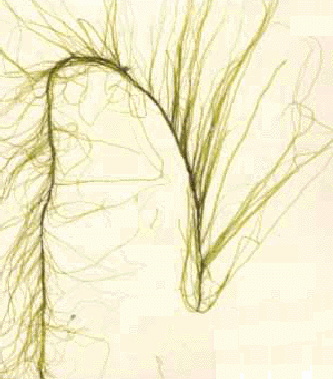
By Bob Goemans


Most aquarists realize it's difficult to find algae on the reef in the wild. Yet, there's always some calcareous and turf algae because they are actually important building components of any natural reef system. But with the reef's surrounding water nutrient poor and herbivores keeping what there is well mowed, little or none is readily visible. Nevertheless, it's another story in shallow inland waterways and bays where nutrients have a tendency to accumulate.
And there are various colors of alga, e.g., green, brown, and red, and it can be single-cell, multicellular, encrusting, slime-like, or plant-like in appearance. Some perform beneficial functions such as the production of oxygen and removal of various toxic compounds, while others can be harmful to fishes and corals.
As for the 'Plant World' in general, most marine plants/algae in the wild are either too large or simply undesirable for aquarium use. Actually, the word 'plants' is a misnomer when discussing algae in general. Algae differ from terrestrial plants because they lack true leaves, root systems, and a system to transport nutrients. Since the term plants continues to be widely used in the aquarium industry, its use will somewhat continue here as appropriate.
In fact, I can remember when a good growth of any kind of green algae in a marine aquarium was time for smiles. That's no longer true in many aquariums, especially that of reef aquariums. Only calcareous algae such as Halimeda or Coralline, or possibly a controlled growth of Caulerpa is considered acceptable, whereas filamentous or slime-like growths are almost always considered problematic and usually become costly in time and money to remedy. Nevertheless, there are many species serving useful purposes, e.g., food source; decorative; shelter; or a means to export nutrients such as those used in refugia or alga turf filters.
And as for one of the most beneficial purposes, their photosynthesis process uses carbon dioxide and in turn provides oxygen for the aquarium animals. This also helps raise system pH and increase system carbonate buffer capacity (alkalinity). They also help to remove unwanted compounds such as ammonium; nitrate and some heavy metals from the bulk water, thereby acting like a form of chemical filtration. Keep in mind the nitrate removed is broken down by internal enzymes, similar to reverse denitrification, until the ammonium needed for growth is attained. Removing or pruning back growth serves as a way to export the absorbed unwanted nutrients.
My Species Library has four sections pertaining to algae/plants, Algae (Brown), Algae (Green), Algae (Red), and Vascular Plants/Seagrasses.
As for the first three, they are based on a color that loosely represents the type of algae or bacteria that fit into its category, i.e., Brown, Green, and Red. A forth is dedicated to Vascular Plants/Seagrasses. Each contains a species list with individual species also possibly having a 'Potential Control Species,' that identifies species that may consume it should it be an undesirable algae/plant species. Hopefully, you will find that additional aspect helpful in controlling unwanted growths in the aquarium.
It would be far beyond the scope of this Library to name all the species that can show up in aquaria or in the trade. However, I'll discuss the more commonly seen species in relation to what is the most beneficial and those that have the potential to create problems in the aquarium and/or give aquarists gray hair!
As noted in the other sections/groupings in this website, there's room for additions and no doubt corrections. I've laid the groundwork, so please let's not criticize, simply pitch in and help! And since this is a visual gathering of this aspect of aquarium keeping, there's little or no related husbandry text explaining the conditions these species require or prefer. However, for that I highly recommend reading my Marine Algae Control Secrets booklet, Julian Sprung's Algae, A Problem Solving Guide, Vincent Hargreaves The Complete Book Of The Marine Aquarium, or Anthony Calfo & Bob Fenner Reef Invertebrates, An Essential Guide to Selection, Care and Compatibility. These books will greatly help you understand the conditions that bring about or sustain these growths and further ways to control or eradicate them.
I'll divide the Green section of this Library into areas, such as 'Macroalgae, which will contain different Caulerpa species, Hair Algae, Bubble Algae, Turf Algae, Calcareous Algae, and Microalgae. Hope you find it helpful.
© 2012 Bob Goemans. All rights reserved.
The material on this site may not be reproduced, distributed, transmitted, cached or otherwise used, except with the prior written permission of Bob Goemans.

